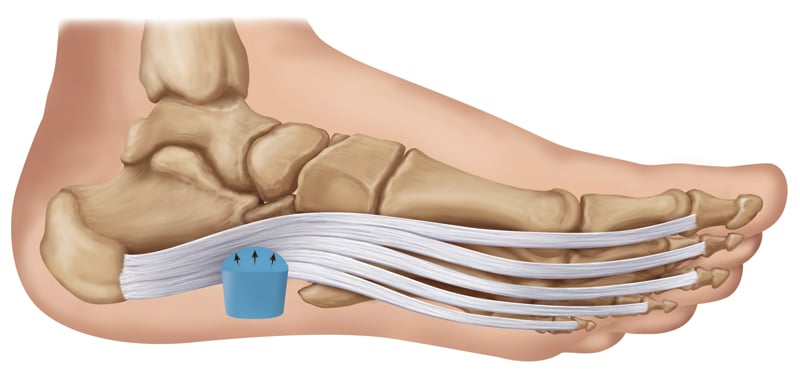Arch Pain? Easy SelfTreatment PhysioPrescription
Plantar Fasciitis: Symptoms, Treatment and Prevention

In this final article in the two part series on Plantar Fasciitis, Brad Walker talks about the normal symptoms of this painful sports accident as well as the utmost effective treatments once diagnosed. Brad also describes some very important precautionary measures that are crucial in avoiding Plantar Fasciitis. A ft . injury such as plantar fasciitis generally occurs in one foot. Bilateral plantar fasciitis is abnormal and is commonly the consequence of a systemic arthritic condition that is exceptionally rare among sportsmen. Males suffer from a somewhat better occurrence of plantar fasciitis than females, perhaps as a result of greater weight coupled with greater velocity and surface impact, as well as less flexibility in the ft ..Typically, the patient of plantar fasciitis experience pain upon increasing after sleep, specially the first step out of foundation. Such pain is tightly localized at the bony landmark on the anterior medial tubercle of the calcaneus. In some cases, pain may avoid the athlete from walking in a standard heel-toe gait, triggering an abnormal walk as means of compensation. Less common regions of pain are the forefoot, Calf msucles, or subtalar joint.After a brief period of walking with this kind of ft . injury, the pain usually subsides, but returns again either with vigorous activity or prolonged standing or walking. Around the field, an modified gait or abnormal stride structure, along with pain during operating or jumping activities are tell-tale signs or symptoms of plantar fasciitis and should be given fast attention. Further signs of the accident include poor dorsiflexion (lifting the forefoot off the ground) anticipated to a shortened gastroc complex, (muscles of the calf). Crouching in a complete squat position with the sole of the ft . flat on the floor can be used as a test, as pain will preclude it for the athlete experiencing plantar fasciitis, triggering an elevation of the heel due to tension in the gastroc complex.TreatmentTreatment of plantar fasciitis may also be a slow and irritating process. An application of rehabilitation should be carried out by making use of someone trained and proficient in the affliction. Typically, plantar fasciitis will require at least six weeks or more to six months of conservative treatment to be fully remedied. Should such work not provide pain relief to the athlete, more ambitious steps including surgery may be considered.The initial goals of physical therapy ought to be to increase the unaggressive flexion of the feet and improve versatility in the foot and ankle, eventually resulting in a full return to normal function. Continuous inactivity in strenuous sports is usually the price to be payed for thorough recovery. 1 / 2 measures can lead to a chronic condition, in some instances severely limiting athletic ability.As a huge timeframe is spent in bed during sleeping time, it is important to ensure that the bedding at the foot of the foundation do not constrict the ft ., leading to plantar flexion in which the foot is bent straight out with the toes pointing. This constricts and in that way shortens the gastroc complex, worsening the problem. A heating system pad positioned under the muscles of the calf for a few momemts prior to increasing may help release tension, increase blood circulation in the lower leg and decrease pain. Also while asleep, a night splint may be used in order to hold the ankle joint in a natural position. This will likely aid in the therapeutic of the plantar fascia and ensure that the ft . won't become flexed at night time.Careful attention to footwear is critical in avoiding feet injuries. Every work should be made to wear comfortable shoes with proper arch support, fostering proper feet posture. Should arch supports prove insufficient, an orthotic boot is highly recommended. Fortunately, most instances of plantar fasciitis answer well to non-operative treatment.Restoration times however differ enormously in one athlete to some other, depending on age group, general health and health as well as severeness of injury. A broad period between 6 weeks and 6 months is usually sufficient for proper curing. Additionally, the mode of treatment must be versatile with respect to the details of a specific athlete?s harm. Methods that show successful in one patient, might not exactly improve the personal injury in another.Early on treatment of feet injuries typically includes the use of anti-inflammatory medication, icing, stretching activities, and heel inserts and splints. Cortisone shots may be necessary to achieve satisfactory curing and retard swelling. In later periods of the rehabilitation process, typically after the first week, glaciers should be discontinued and changed with heat and massage.It is very important that any activity known to produce irritability or stress to the plantar fascia be immediately discontinued, including any activity relating repeated impact of the heel on a hard surface, particularly, jogging. Should pain from the accident persist, additional diagnostic studies should be performed to eliminate other, more spectacular factors behind heel pain including stress fractures, nerve compression traumas, or collagen disorders of the skin.
Arch Pain? Easy SelfTreatment PhysioPrescription's Picture
Related Images with Arch Pain? Easy SelfTreatment PhysioPrescription
Triggerpoint Total Treatment for Plantar Fasciitis and Foot Pain TPT

in the condition of plantar fasciitis the elastic plantar fascia

Plantar Fasciitis Secrets Revealed Review How To Treat Plantar

Arch Pain? Easy SelfTreatment PhysioPrescription




0 komentar: